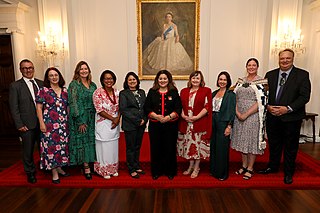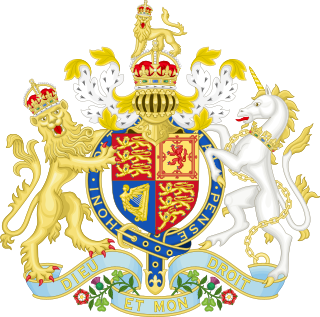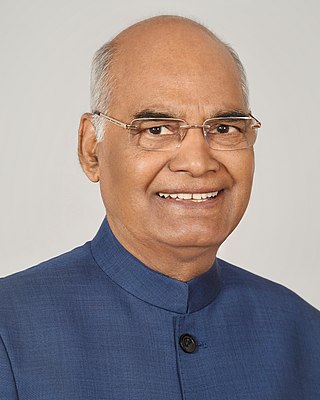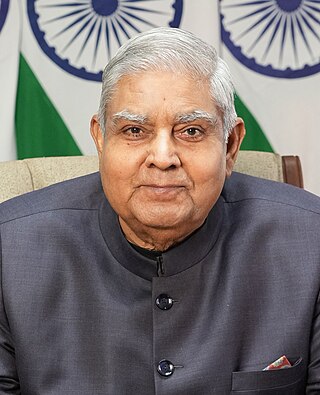| |||||
| Centuries: | |||||
|---|---|---|---|---|---|
| Decades: | |||||
| See also: | List of years in India Timeline of Indian history | ||||
Events in the year 1774 in India.
| |||||
| Centuries: | |||||
|---|---|---|---|---|---|
| Decades: | |||||
| See also: | List of years in India Timeline of Indian history | ||||
Events in the year 1774 in India.

The president of India is the head of state of the Republic of India. The president is the nominal head of the executive, the first citizen of the country, as well as the supreme commander of the Indian Armed Forces. Droupadi Murmu is the 15th and current president, having taken office from 25 July 2022.

A viceroy is an official who reigns over a polity in the name of and as the representative of the monarch of the territory.

The governor-general of India was the representative of the monarch of the United Kingdom in their capacity as the Emperor/Empress of India and after Indian independence in 1947, the representative of the Monarch of India. The office was created in 1773, with the title of Governor-General of the Presidency of Fort William. The officer had direct control only over his presidency but supervised other East India Company officials in India. Complete authority over all of British territory in the Indian subcontinent was granted in 1833, and the official came to be known as the "Governor-General of India".

The Reserve Bank of India, abbreviated as RBI, is India's central bank and regulatory body responsible for regulation of the Indian banking system. Owned by the Ministry of Finance, Government of India, it is responsible for the control, issue and maintaining supply of the Indian rupee. It also manages the country's main payment systems and works to promote its economic development. Bharatiya Reserve Bank Note Mudran (BRBNM) is a specialised division of RBI through which it prints and mints Indian currency notes (INR) in two of its currency printing presses located in Mysore and Salboni. The RBI, along with the Indian Banks' Association, established the National Payments Corporation of India to promote and regulate the payment and settlement systems in India. Deposit Insurance and Credit Guarantee Corporation was established by RBI as one of its specialized division for the purpose of providing insurance of deposits and guaranteeing of credit facilities to all Indian banks.

India is a federal union comprising 28 states and 8 union territories, for a total of 36 entities. The states and union territories are further subdivided into 806 districts and smaller administrative divisions.

The Indian Independence Act 1947 is an act of the Parliament of the United Kingdom that partitioned British India into the two new independent dominions of India and Pakistan. The Act received Royal Assent on 18 July 1947 and thus modern-day India and Pakistan, comprising west and east regions, came into being on 15 August.
A member of the Legislative Assembly (MLA) is a representative elected by the voters of an electoral district (constituency) to the legislature of State government in the Indian system of government. From each constituency, the people elect one representative who then becomes a member of the Legislative Assembly (MLA). Each state has between seven and nine MLAs for every Member of Parliament (MP) that it has in the Lok Sabha, the lower house of India's bicameral parliament. There are also members in three unicameral legislatures in Union Territories: the Delhi Legislative Assembly, Jammu and Kashmir Legislative Assembly and the Puducherry Legislative Assembly. Only a Member of the Legislative Assembly can work as a minister for more than 6 months. If a non-Member of the Legislative Assembly becomes a Chief Minister or a minister, he must become an MLA within 6 months to continue in the job. Only a Member of the Legislative Assembly can become the Speaker of the Legislature.

The Bengal Presidency, officially the Presidency of Fort William in Bengal, later the Bengal Province, was the largest of all three presidencies of British India during Company rule and later a province of India. At the height of its territorial jurisdiction, it covered large parts of what is now South Asia and Southeast Asia. Bengal proper covered the ethno-linguistic region of Bengal. Calcutta, the city which grew around Fort William, was the capital of the Bengal Presidency. For many years, the governor of Bengal was concurrently the governor-general of India and Calcutta was the capital of India until 1911.
In India, a governor is the constitutional head of a state of India that has similar powers and functions at the state level as those of the president of India at the central level. A governor acts as the constitutional head and takes all their decisions based on the advice of chief minister and their council of ministers.

The provinces of India, earlier presidencies of British India and still earlier, presidency towns, were the administrative divisions of British governance on the Indian subcontinent. Collectively, they have been called British India. In one form or another, they existed between 1612 and 1947, conventionally divided into three historical periods:
State Governments of India are the governments ruling over the 28 states and 3 union territories of India with the head of Council of Ministers in every state being the Chief Minister. Power is divided between the Union government and the state governments.

In India, a chief minister is the elected head of government of each state out of the 28 states and sometimes a union territory (UT). Currently, only the UTs of Delhi, Jammu and Kashmir and Puducherry have serving chief ministers. According to the Constitution of India, the governor is a state's head, but de facto executive authority rests with the chief minister.

Ram Nath Kovind is an Indian politician and lawyer who served as the 14th president of India from 2017 to 2022. He is the first person from Uttar Pradesh to serve as President of India. He is a member of the Bharatiya Janata Party and also the first person from BJP to become the President of India. Prior to his presidency, he served as the 26th Governor of Bihar from 2015 to 2017. He also served as a Member of Rajya Sabha from 1994 to 2006. Before entering politics, he was a lawyer for 16 years and practised in the Delhi High Court and the Supreme Court of India until 1993.

Jagdeep Dhankhar is an Indian politician and lawyer, serving as the 14th and current vice president of India since 2022. He previously served as the Governor of West Bengal from 2019 to 2022. He also served as a Union Minister of State for Parliamentary Affairs in the Chandra Shekhar ministry from 1990 to 1991. He was a member of Lok Sabha from 1989 to 1991 and later a Member of Rajasthan Legislative Assembly from 1993 to 1998. He has also been affiliated with multiple political parties in India, including the Bharatiya Janata Party, Indian National Congress and Janata Dal.